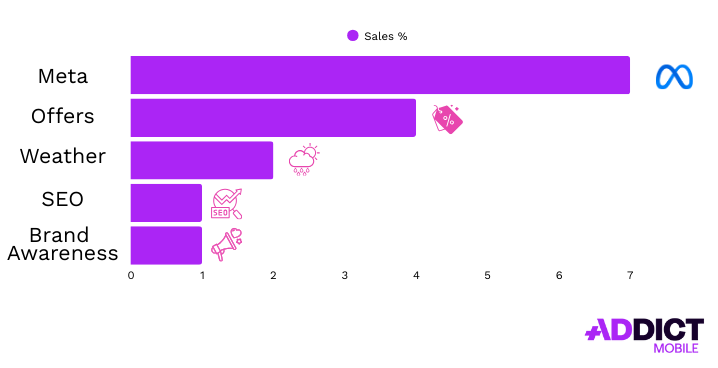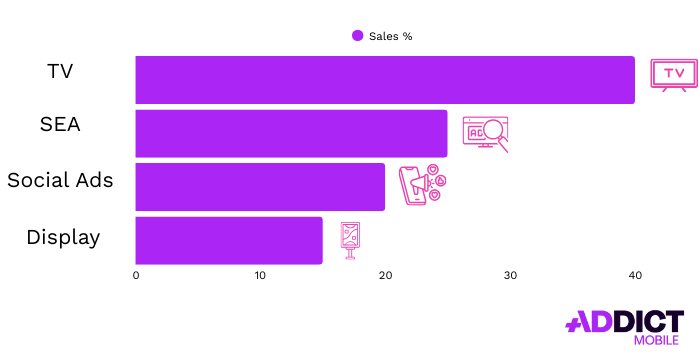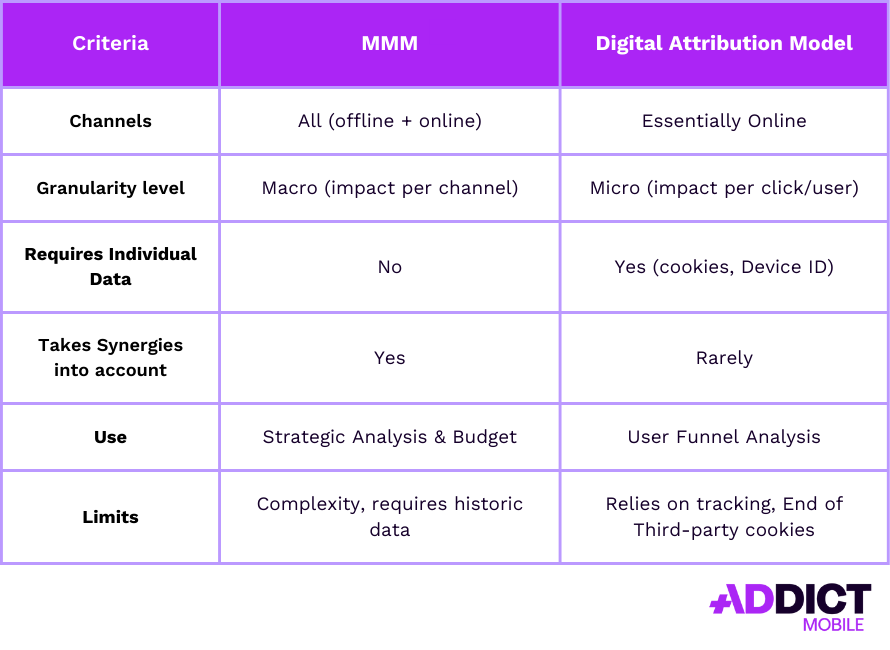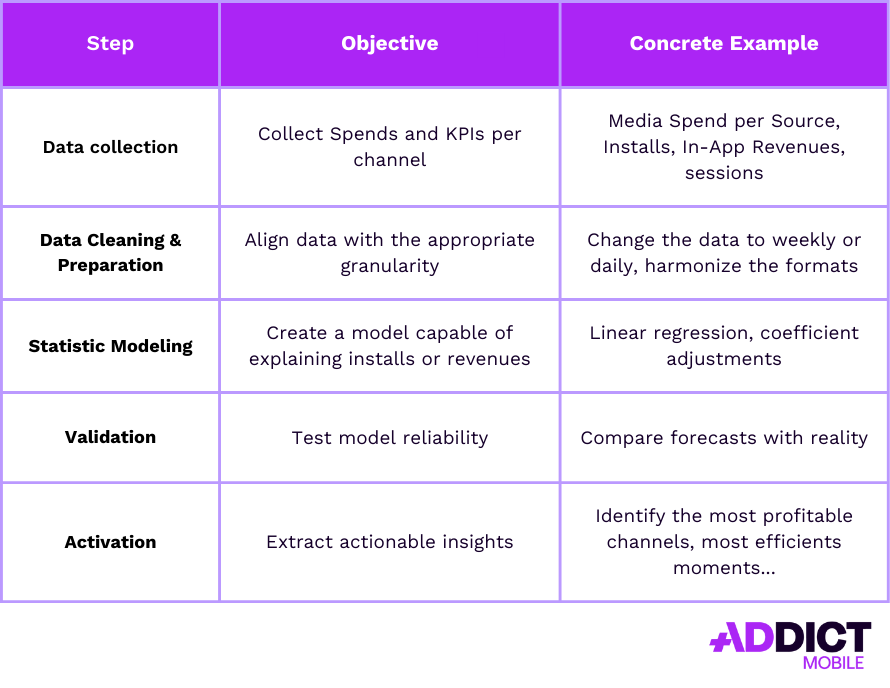Marketing Mix Modeling (MMM): Definition, How It Works, and Best Practices
Introduction
As marketers face the demise of cookies, increasingly fragmented customer journeys, and growing expectations for performance measurement, Marketing Mix Modeling (MMM) is making a strong comeback.
Historically used by large brands to measure the impact of offline advertising (TV, radio, print), MMM is now adapting to new digital and mobile challenges. It has become a strategic ally for managing marketing investments, combining data science with statistical analysis.
What Is Marketing Mix Modeling?
Definition
Marketing Mix Modeling (MMM) is a statistical analysis method that identifies and quantifies the impact of different marketing levers on business outcomes.
It’s a macro approach: instead of tracking individual consumer journeys, it analyzes major trends based on available historical data.
Simple definition:
“MMM tells you what really drove business results in a complex marketing plan.”
How Does It Work?
MMM is based on econometric models. The idea is to analyze performance variations (sales, leads, downloads…) in relation to changes in marketing investments and external factors.
Concrete Example:
A food delivery app wants to understand why its sales grew by 15% in Q1.
The model will analyze:
- Advertising investments: Facebook, TikTok, TV, Google
- Promotions and coupons
- Weather conditions (e.g., more orders on rainy days)
- Holidays
- Price increases
- Competition
The MMM output will assign a weight to each factor contributing to the observed growth.
Result:
After analyzing its campaign data, the meal delivery service in question will be able to attribute its sales as follows:
- 7% from Meta ads
- 4% from promotions
- 2% from weather
- 1% from SEO
- 1% from brand awareness

What Is MMM Used For?
Marketing Mix Modeling is primarily a decision-making tool. In an environment where marketing channels (TV, radio, out-of-home, digital, social, influencer, retail, etc.) and user devices are multiplying, it becomes increasingly difficult to know what actually works and how to optimize investments. MMM helps answer the key question:
What truly drives performance?
It’s particularly helpful in addressing key issues in app marketing.
Mesurer l’impact des campagnes publicitaires
MMM can attribute a portion of results (sales, downloads, leads…) to each marketing channel used.
Example: A beauty brand running TV ads, SEA, Instagram campaigns, and subway billboards can determine the contribution of each channel to total sales.

With this insight, the advertiser can invest more in the channels delivering the most value.
Optimize Budget Allocation
Once channel performance is identified, MMM helps marketing teams better allocate budgets.
Example:
If TV campaigns are effective but reaching saturation (declining ROI per additional dollar spent), it may be more profitable to shift budget to social ads or search.
MMM can answer concrete questions like:
- Should I cut out-of-home to boost digital?
- Am I over-investing in one channel?
- What’s the saturation point of my TV campaigns?
Forecast Results and Test New Strategies
MMM is also a scenario simulation tool.
Example:
A retailer wants to run a media plan without TV for a quarter but increase digital investment by 50%. MMM can estimate the expected impact of this new mix on sales.
It’s a true forecasting tool to test hypotheses before actually spending the budget.
Adjust Strategies for Seasonality
MMM accounts for external and seasonal effects like sales, Christmas, Black Friday, weather, school holidays…
Example:
A beverage brand may see that hot weather naturally boosts sales, regardless of ads. In contrast, in winter, ad campaigns have more impact due to lower organic sales.
This helps adapt strategies to context rather than relying on a fixed yearly budget.
Benefits of Marketing Mix Modeling
Beyond performance measurement, MMM offers several key advantages that make it increasingly attractive to advertisers, especially in retail, CPG, finance, and gaming.
Covers All Marketing Channels, Even Offline
Unlike digital attribution models (often limited to web or mobile), MMM also includes the impact of traditional channels: TV, radio, out-of-home, print, event sponsorship, etc.
Example:
A brand running a national TV campaign alongside TikTok ads can use MMM to measure the respective impact of both and check for cross-channel amplification.
Accounts for Indirect Effects and Channel Synergies
MMM goes beyond siloed analysis. It integrates synergy effects.
Example:
A TV ad boosts brand awareness → increases Google searches → leads to more conversions via SEA.
MMM can model this cascade effect and provide a holistic view of multi-lever campaigns.
Helps Forecast Future Outcomes
Once built, the model can predict results based on budget allocations. It allows marketing teams to simulate action plans and identify the best mix for maximizing results.
Simulation example:
“If I increase social ad budget by 30% and cut out-of-home, what’s the estimated sales impact next month?”
MMM thus becomes a strategic forecasting tool for business planning.
MMM vs. Traditional Attribution Models
Here’s a comparison to clarify the differences.

Explanation:
- Traditional attribution models (last-click, first-click, linear…) focus on the digital user journey: they explain who clicked and where.
- MMM takes a step back: it analyzes the overall effect of marketing investments, including offline, and works without cookies or individual tracking.
The 4 Key Steps of Marketing Mix Modeling
Data Collection
Start by aggregating all available data on sales, marketing spend by channel, and external factors like weather, sales periods, holidays, etc.
Examples of sources:
- Media spend by channel
- Sales / Revenue / Downloads
- Price history
- External business data (inflation, seasonality…)
Modeling
This is the statistical analysis phase: data scientists create mathematical models (often multiple regressions) to explain variations in sales based on investments.
Analysis
Once the model is stable, results are delivered as business insights:
- Contribution of each channel to sales
- ROI per channel
- Saturation point
- Synergy effects
Optimization
The final step is simulating scenarios to optimize investments.
Example:
A retail advertiser might test several budget allocations:
- Scenario 1: +20% TV budget
- Scenario 2: -30% out-of-home, +40% social
- Scenario 3: Constant budget, but reallocated between search and influencer

Do not hesitate to contact with our teams
Addict can support you to improve your performance.
MMM for App Marketing: Nuances and Best Practices
Why MMM Is Crucial in App Marketing
App marketing is particularly tricky for performance measurement. With Apple’s App Tracking Transparency (ATT), the decline of third-party data, and cross-device user journeys, mobile marketers have fewer actionable individual signals.
MMM is valuable in this context because:
- It doesn’t rely on individual user data
- It measures campaign impact on business KPIs (installs, activations, revenue) using only aggregated data
- It works across all platforms and traffic sources—even untrackable environments (like TV, OOH, or iOS ads)
MMM Specificities in Mobile
Originally used for offline or e-commerce products, MMM requires some adjustments for mobile marketing.
- Short purchase cycles: User actions in apps (install, sign-up, purchase) are almost immediate. MMM needs to work with fine time granularity (daily or weekly) to capture short-term effects.
- Variable data volumes: Some apps generate massive install volumes, others much less. MMM works best with large datasets. Smaller apps may need to aggregate months of data to spot reliable trends.
- Accounting for organic uplift: Paid campaigns can increase organic installs (e.g., App Store ranking boost, word-of-mouth). A good MMM model should isolate and estimate this “halo” effect.
- Multiple media sources: MMM should integrate various channels:
How to Build an MMM for an App
Here are the main steps to build an MMM model tailored for mobile marketing:

MMM Limitations in App Marketing
Like any statistical approach, MMM has limitations:
- It provides a macro view (less precise than user-level tracking)
- Requires advanced data science expertise
- Sensitive to data quality and granularity
Still, in a post-ATT world, it’s increasingly seen as an essential pillar of data-driven mobile marketing.
Key Takeaways
- MMM is essential for analyzing 360° media plans
- It complements (but doesn’t replace) digital attribution tools
- It’s a powerful budget optimization tool
- It requires data maturity to deploy effectively
Conclusion
Marketing Mix Modeling is becoming a vital strategic tool, especially in a privacy-first world with disappearing cookies. It helps brands make better budget decisions based on a comprehensive, objective view of marketing performance.


